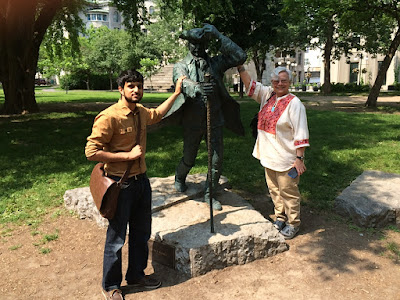The Islamic Studies Library at McGill will be holding a calligraphy workshop with Iranian calligrapher Sussan Sheikh on July 29th, from 2-4pm in the Octagon Room. Sussan Sheikh studied with Abdollah Foradi and Yadollah Kaboli in Iran in the 1980s, and received the rank of "excellent" from the Anjuman-i Khushnawīsān-i Īrān in 1988. (Reposted from the Islamic Studies Library: http://is.gd/v0Gas3.)
Wednesday, July 22, 2015
Thursday, July 16, 2015
Frances Pritchett's Visit to Montreal
Beginning last week, Columbia Professor Emerita of Modern Indic Languages Fran Pritchett visited my gharīb-khānah in Montreal. Fran is a dear friend, my former PhD adviser, and the creator of the online dīwān of Ghālib, A Desertful of Roses. I took her around the city, and introduced her to her grand-students David Wong, Geneviève Mercier-Dalphond, Zain Mian, and Jessica Stilwell. Fran enjoyed it very much, for, as she said,
"I can give them whatever advice I like and then go away, and it's up to you to feed them and change their diapers."Below are some photos from her trip.
Tuesday, July 7, 2015
Digital Exhibition from the Islamic Studies Library: The Persianate Literary Heritage
Thanks to Islamic Studies Liaison Librarian Sean Swanick, much of the marvellous Persian Literary Heritage exhibition that graced McLennan Library in 2014 during the 10th biennial Iranian Studies Conference is now available online. The beginnings of our collection of Persian materials pre-dates the creation of the Institute of Islamic Studies and the Islamic Studies Library in 1952. The materials in the Blacker-Wood collection were chosen by the Russian Orientalist Wladimir Ivanow, who also catalogued materials at the Royal Asiatic Society of Bengal.
The digital exhibit includes 6 items from South Asia, including a portrait of the 18th-century Mughal ruler Farrukhsiyar. Then there is MS 53, depicting a young woman in profile with a strikingly curved and thick eyebrow.
This painting is described in Glen Lowry’s unpublished 1977 catalogue as a "Miniature of a Princess" from c. 1650. (See Swanick’s page on McGill's Islamic manuscripts, including catalogues by Adam Gacek, Ivanow, and Lowry). It bears an inscription in the upper right indicating the name of the woman. If we take the third element of the name as a lām-alif in which the alif has absconded, this lady may have been called "Almās Bā’ī"—"Miss Diamond." One imagines that this could as easily be the name of a courtesan or other professional as of a princess, but perhaps Lowry had some reason for so designating her.
Subscribe to:
Comments (Atom)








